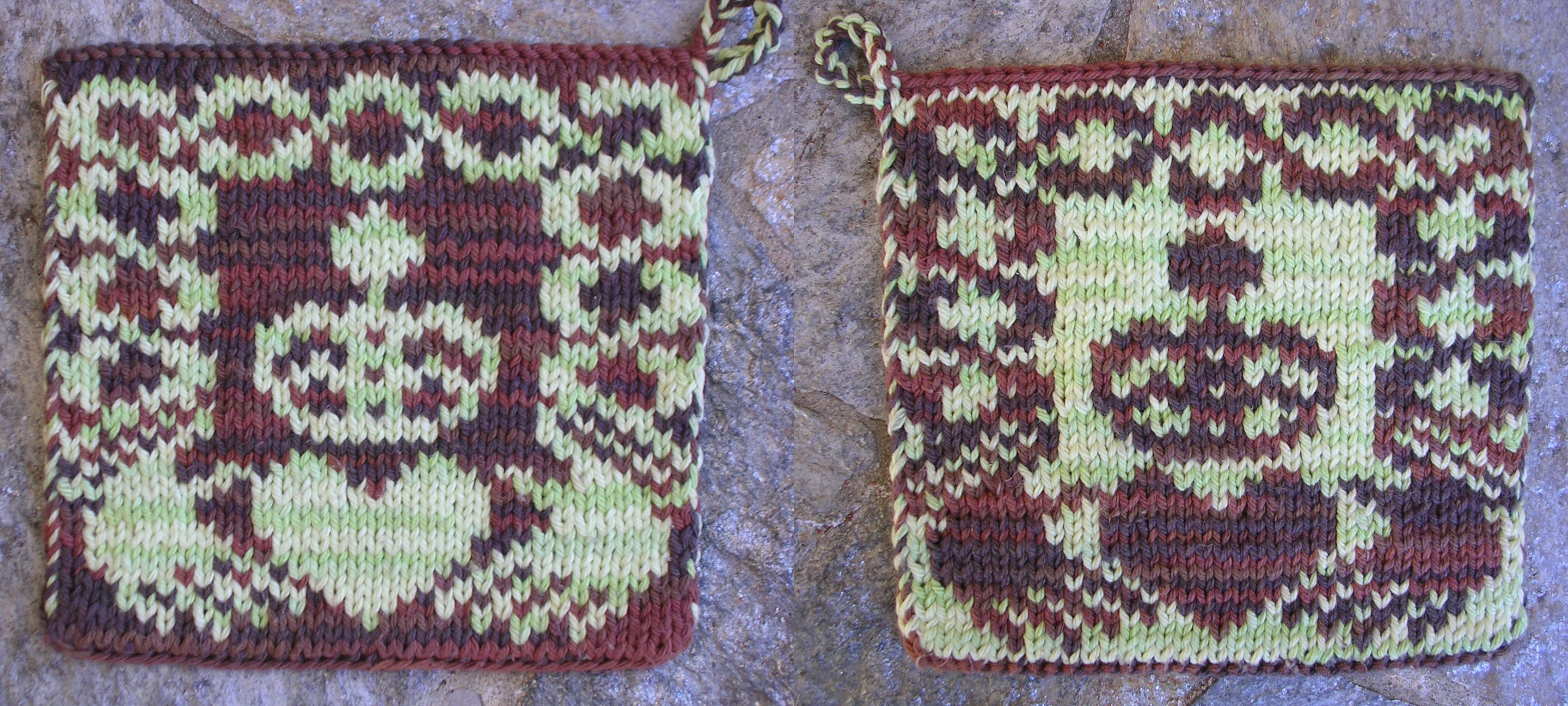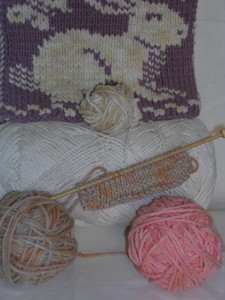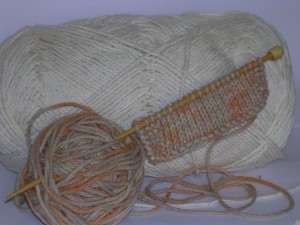Cotton Yarn Dying or Staining (still under construction)
Why am I Dying Yarn?
While I love the huge variety of bright cheerful colors of Lily’s Sugar ‘n Cream yarns, most of their fun, multicolored yarn patterns are too distracting to use with intricate double knitting patterns.  I’ve purchased huge a large stock of these multicolored yarns since I love looking at them, but when it comes to designing them into a double knit potholder, my test samples show they will mask or compete with the potholder pattern.
And yet I find their subtle color changing yarns look really nice with double knitting and give more depth and interest to the completed project. Â Example is the Claddagh Potholder.

Claddagh Potholder
My methods are based on yarn dying searches off the web and then just trial and error with household items I had on hand and a bit of logic (Hmmm, what has stained my favorite tee-shirts in the past?).
Things You’ll Need:
White cotton yarn Soap (dish soap or laundry soap) Baking Soda White Vinegar Color Agent Thickener – I used Citrucel (Methylcellulose).  This works well because it is pH stable for a wide range of pH.  Helps keep the yarn/dye wet and controls dripping. ÂYarn Prep:
- Determine yarn requirements and add about 10% for safe measure.  For Double knitting I found that each ‘square’ on the pattern requires slightly less than an inch of yarn. Â
- Example: Â If the pattern is 25 rows by 20 stitches wide. Â 25 x 20 = 500″ or 13.8 yards. Â Add 10% = 13.8 + 1.4 = 15.2 yards. Â (Plus you may want to add and extra 1-2 yards for ends to weave in or potholder loops)
- Prep tie-offs. Â Cut 4-6, 10″ strips of a dark color yarn
- Create a yarn yank, by loosely wrapping yarn off the ball around something 20″ -35″ apart depending on repeat desired and the total amount of yarn to manage. Â A large cutting board, chair arms or someone’s helping hand will work.
- Before taking yarn yank off the board, tie with a single knot and bow (for easy removal later) every 5-10″. Â This will help keep the yarn from tangling during the washing processes.
- Optional: Â If you wrap 2-5 time and tie tight color will have difficulty getting behind the tie and you can get a lighter or white banding, like in tie dye.
- Remove yarn from board and dye.
Yarn Coloring – Â general process:
- Gently wash white yarn with laundry or dish soap to remove any potential finishing or sizing that might prevent the color from adhering.
- Raise the yarn pH, by mixing ~2T baking soda (Sodium Bicarbonate, aka soda ash) in ~1/2 C water and soak the yarn for about 5 mins in this solution.  Approximate pH is 8.3 and is not harmful to touch.  I read that this helps the ‘dye’ cling to the yarn.  Yarn is cationic and needs an anionic charge to attract and attach dye molecules to the yarn.
- Lightly wring out excess until very wet, but not dripping and then lay flat (in a glass or plastic tray) for dying.
- Add coloring agent. Â I ‘glob’ or ‘paint’ the colors which may be part pasty and part runny in bands about 2 or 3 inches wide and leave a white apart between dyed sections or as desired to create highs and lows color concentrations.
- Â Let color soak in for 1-8 hrs. Â The color on the yarn will only be about 1/10th as dark after final rinse. Â Might want to include about 5 test stripes to test the color strength with out disturbing the yarn batch or make the test stripes first to test color strength.
- In large bowl or under the facet rinse coloring agents out until it stops bleeding into water.
- Neutralize the yarn, by soaking the yarn in about 1 quart of water and 1/4 cup of white vinegar for 1-2 mins.
- Gently wash yarn in warm water and soap. Â Rinse and let air dry or use hair dryer to speed-up (Heat may help set color?) .
What’ have I tried to dye/stain cotton yarn:
Food color (& baking soda)Â – Didn’t work the way I thought. Â I tried Wilton’s orange, red and purple and they did stain or dye the yarn, but only a bright pink stays after washing & rinsing each of these colors. Â I also tried yellow and green, but these washed out completely. Â Color developed fast: 1-3 hours gives a good color.
Soy Sauce (& baking soda) - Didn’t work, washed out
Annatto (& baking soda) – Works great to make orange-yellow yarn.  Annatto is a cheap spice & food coloring agent used to color butter and cheese (yeap natural cheddar cheese is whitish without out this).  I mixed ~1.5 Tbsp Annatto with 1 tsp Baking soda and 1/3 C tap water.  I painted the colored liquid part on the yarn.  Color developed fast: 1-3 hours gives a good color.
Coffee (& baking soda) –  Works, but washes out to light tan.  I mixed ~1/4 cup of ground coffee with 1/2 C hot water and then microwaved and cooled 2 cycles to extract more color out.  Once cooled added ~3T baking soda, since coffee is naturely acidic (not it will foam up so do this in a tall cup).  I glopped the ground and colored liquid on the yarn.  Color developed slow: 2-6 hours gives a light color.
Black Tea (& baking soda) –  Works, but washes out to light tan slightly rustier and darker than coffee.  I used Lipton tea and cut the tea out of the tea bags and then followed the same process of steeping the color as I did with coffee.
Green Tea (& baking soda) –  Works, but washes out to light yellow tan and was lighter than coffee stained color.  I used cut the tea out of the tea bags and then followed the same process of steeping the color as I did with coffee.
Pastels – Didn’t work. Â I used high end Artist pastels. Â I trialed several colors, ground up and mashed into the baking soda soaked yarn. Â I let sit over night, 12+ hours and all of the colors washed out.
Sweet Gumball Tree Balls – I made a tea, by steeping a pot full of balls and then simmered down the liquid into half it’s volume. Â This did color the yarn and made a tan a few shades darker than coffee or tea, plus it was free since I have tons in my yard. Â A sample is shown in the yarn ball and knitted swatch above. Â It also has stripes of annatto & red food coloring which were mixed with the tea to tone down their brightness.
Things I want to try: Â red wine, mustard, ketch-up/tomato sauce and salt (may help make the colors darker). Â This website is a book full of ideas: Â http://www.cs.arizona.edu/patterns/weaving/monographs/fms_dye.pdf



Pingback: About sg-creations.org | sg-creations
Pingback: Lil' Alice Pot Holder | sg-creations